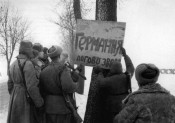
The Vistula-Oder offensive operation has ended
On February 3, 1945, one of the most significant military operations of the Second World War came to an end, during which Soviet forces liberated a large part of Poland and approached the outskirts of the German capital.
By the beginning of 1945, the armed forces of the Soviet Union and the allies in the anti-Hitler coalition had approached the borders of Germany from both the east and the west. The Wehrmacht's main forces, consisting of 185 divisions, were concentrated along the contact line with Soviet troops, from the Baltic Sea to the Carpathian Mountains. The Supreme High Command Headquarters planned to launch active hostilities on all fronts, followed by a deep offensive and the capture of Berlin.
The main attack was to be conducted by the 1st Belorussian Front (commanded by G. K. Zhukov) and 1st Ukrainian Front (commanded by I. S. Konev), which held three operational bridgeheads on the western bank of the Vistula River and had a total of 134 divisions with a strength of 2.2 million men.. In Poland, the German army group "A", also known as "Center", numbering 30 divisions, opposed them. They had prepared a deeply echeloned defense between the Vistula and Oder, consisting of seven defensive lines up to 500 kilometers deep. The approaches to these lines were covered with wire barriers, minefields, and anti-tank ditches.
The timing of the operation was influenced by an appeal made by British Prime Minister Winston Churchill to Joseph Stalin on January 6th, 1945. Since the end of December, the Allies on the Western Front had been holding back a German offensive in the Ardennes, and they were interested in launching an offensive on the Soviet-German front in order to distract some of the Wehrmacht's forces.
On January 7th, Stalin responded to Churchill's message, stating that the Supreme High Command Headquarters had decided to accelerate preparations and, regardless of weather conditions, launch wide-scale offensive operations against the Germans on the central front no later than the second half of January.
The 1st Ukrainian Front went on the offensive on January 12, 1945, followed by the troops of the 1st Belorussian Front two days later on January 14. The Red Army advanced rapidly and broke through the enemy's defenses, crossing the Nida, Warta, and Pilica rivers. They liberated the cities of Kielce, Czestochowa, and Krakow on January 15. On January 17, Warsaw was also liberated with the help of Polish troops.
During the first days of the operation, the main forces of the 9th and 4th tank armies were defeated and the enemy's defenses were breached over a wide area of 500 kilometers and a depth of 100-160 kilometers. In order to prevent the enemy from establishing new defensive positions, the troops of both fronts began pursuing the retreating German forces on January 18.
On January 19th, formations of the 1st Ukrainian Front crossed the Polish-German border and liberated Krakow. After intense fighting on January 22nd-25th, they reached the Oder River. Troops of the 1st Belorussian Front also liberated Lodz and blocked the enemy garrison in Poznan. By February 3rd, the front had reached the Oder and established bridgeheads near Kustrin. Berlin was only 70 kilometers away, but the Stavka decided against a further offensive due to the possibility of a German counterattack from Pomerania on the rear of Soviet troops that had reached the Oder. Instead, the offensive on Berlin was postponed until the defeat of the enemy in Pomerania was complete.
By the time the Vistula-Oder operation was completed, the Soviet offensive had increased in width from 500 kilometers to 1,000 kilometers. In just 23 days, Soviet troops had advanced to a depth of 500 kilometers, liberating a significant part of Poland and reaching the outskirts of the German capital. During this operation, 35 enemy divisions were defeated and another 25 suffered losses ranging from 50% to 70% in terms of men, weapons, and military equipment.
Lit.: Абатуров В. К 70-летию освобождения Варшавы: Висло-Одерская наступательная операция 12 января–3 февраля 1945 г. // Министерство обороны Российской Федерации [Электронный ресурс]. Режим доступа: https://stat.mil.ru; Киселёв В. Н. Почерк двух полководцев. Жуков и Конев в Висло-Одерской операции. // «Военно-исторический журнал». 1995. № 1. С.4–11; Конев И. С. Сорок пятый. М., 1970; Макар И. П. От Вислы до Одера. Из опыта деятельности советских органов стратегического руководства при подготовке и в ходе Висло-Одерской стратегической наступательной операции 1945 года. // «Военно-исторический журнал». 2005. № 3. С.2–9.
Based on the materials of Presidential Library:
Замятин Н. М. От Вислы до Одера. М., 1947 (доступно в электронном читальном зале);

